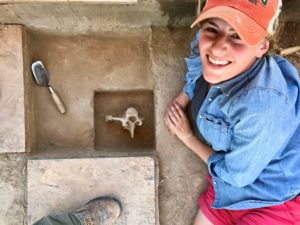
Story by Richard Adams
Carson Black, an anthropology student at Colorado State University, spent her summer getting her hands dirty.
Black participated in CSU’s paleontology field school in Wyoming’s Big Horn Basin run by Kim Nichols. Hungry for more field experience, Black looked for more anthropology opportunities upon completion of that program. Fortunately for her, location and luck were on her side as she was able to volunteer with the crew at the La Prele mammoth archaeological site which is just ten miles west of her hometown of Douglas, Wyoming.
The La Prele mammoth was discovered in 1986 by avocational archaeologists from Douglas and was excavated by University of Wyoming’s Dr. George C. Frison the next year. Frison recovered a head-less partial mammoth, one chipped stone tool and a small amount of flintknapping debris. Because of landowner issues, work at the site stalled for almost two decades. After a reassessment of the site in 2014, archaeologists from the University of Wyoming and other institutions (including Colorado State University) started conducting field work. This past summer marked the fourth year.
The La Prele excavation site has grown in size and complexity over the past four years, with excavators unearthing artifacts like chipped stone tools, a red ocher stain, and a couple of finely-crafted bone needles. Despite four seasons of digging, no weapons had been found. For everyone working the La Prele mammoth site, finding a Clovis projectile point (stone spear point distinct to the Clovis culture) would be like striking gold.
Roughly 25 seasoned archaeologists and graduate students made up the La Prele mammoth site team this summer. Black was the youngest and least experienced of the bunch, but her first day nerves were soon replaced as she proved her skill and built comradery with the rest of the team.
“The days were really long and hot, but it didn’t matter because we were all having a complete blast. I didn’t want it to end,” said Black. This teamwork and comradery helped the summer 2017 excavation team make history.
On the morning of July 16, University of Oklahoma graduate student Megan Dudley found the tip of a Clovis point in a test unit that had been started by CSU alumnus Connor Johnen (B.A. ’14).

Serendipitously, Black’s family had been visiting the archaeological site that same day so they got to share in the excitement of the entire La Prele team as they uncovered the 13,000-year-old projectile point, lethal enough to kill a mammoth.
“It was really neat to see my family as excited as I was about the Clovis point,” said Black. “They have been extremely supportive of my time at CSU and have shown so much interest in my pursuit of a career in anthropology.”
In addition to Black and Johnen, several other CSU anthropology students and alumni have work on the La Prele mammoth site including: Spencer Pelton, M.A. ‘13; Cody Newton, M.A. ‘08, Hallie Meeker, M.A. ‘17; undergraduate Jakob Corbin, and anthropology instructor Richard Adams.
The Department of Anthropology is inside the College of Liberal Arts.